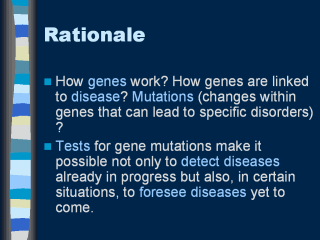|
|
|
|
front |1 |2 |3 |4 |5 |6 |7 |8 |9 |10 |11 |12 |13 |14 |15 |16 |17 |18 |19 |20 |21 |22 |23 |24 |25 |26 |27 |28 |29 |30 |31 |32 |33 |34 |35 |36 |37 |38 |39 |40 |Glossary |review |
 |
Genes - the chemical messages of heredity -
constitute a blueprint of our possibilities and limitations. The legacy of
generations of ancestors, our genes carry the key to our similarities and our
uniqueness. When genes are working properly, our bodies develop and function
smoothly. But should a single gene - even a tiny segment of a single gene - go
awry, the effect can be dramatic: deformities and disease, even death. In the past 20 years, amazing new techniques have allowed scientists to learn a great deal about how genes work and how genes are linked to disease. Increasingly, researchers are able to identify mutations, changes within genes that can lead to specific disorders. Tests for gene mutations make it possible not only to detect diseases already in progress but also, in certain situations, to foresee diseases yet to come. This new ability raises both high hopes and grave concerns. On the one hand, predictive gene testing holds out the possibility of saving thousands of lives through prevention or early detection. On the other, the implications of test results are enormous, not only for the individual but also for relatives who share this genetic legacy, and for society as a whole. In the past 20 years, amazing new techniques have allowed scientists to learn a great deal about how genes work and how genes are linked to disease. Increasingly, researchers are able to identify mutations, changes within genes that can lead to specific disorders. Tests for gene mutations make it possible not only to detect diseases already in progress but also, in certain situations, to foresee diseases yet to come. This new ability raises both high hopes and grave concerns. On the one hand, predictive gene testing holds out the possibility of saving thousands of lives through prevention or early detection. On the other, the implications of test results are enormous, not only for the individual but also for relatives who share this genetic legacy, and for society as a whole. |